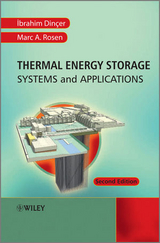
Thermal Energy Storage
Systems and Applications
Seiten
2002
John Wiley & Sons Ltd (Verlag)
978-0-471-49573-4 (ISBN)
John Wiley & Sons Ltd (Verlag)
978-0-471-49573-4 (ISBN)
- Titel ist leider vergriffen;
keine Neuauflage - Artikel merken
Zu diesem Artikel existiert eine Nachauflage
Many research and development activities related to energy have concentrated on efficient energy use and energy savings. In this regard, Thermal Energy Storage (TES) systems can play an important role, as they provide great potential for facilitating energy savings and reducing environmental impact. This book deals with this topic.
During the last two decades many research and development activities related to energy have concentrated on efficient energy use and energy savings and conservation. In this regard, Thermal Energy Storage (TES) systems can play an important role, as they provide great potential for facilitating energy savings and reducing environmental impact. Thermal storage has received increasing interest in recent years in terms of its applications, and the enormous potential it offers both for more effective use of thermal equipment and for economic, large-scale energy substitutions. Indeed, TES appears to provide one of the most advantageous solutions for correcting the mismatch that often occurs between the supply and demand of energy. Despite this increase in attention, no book is currently available which comprehensively covers TES. Presenting contributions from prominent researchers and scientists, this book is primarily concerned with TES systems and their applications.
It begins with a brief summary of general aspects of thermodynamics, fluid mechanics and heat transfer, and then goes on to discuss energy storage technologies, environmental aspects of TES, energy and exergy analyses, and practical applications. Furthermore, this book provides coverage of the theoretical, experimental and numerical techniques employed in the field of thermal storage. Numerous case studies and illustrative examples are included throughout.
Some of the unique features of this book include: - State-of-the art descriptions of many facets of TES systems and applications - In-depth coverage of exergy analysis and thermodynamic optimization of TES systems - Extensive new material on TES technologies, including advances due to innovations in sensible- and latent-energy storage - Key chapters on environmental issues, sustainable development and energy savings - Extensive coverage of practical aspects of the design, evaluation, selection and implementation of TES systems - Wide coverage of TES-system modelling, ranging in level from elementary to advanced - Abundant design examples, case studies and references In short, this book forms a valuable reference resource for practicing engineers and researchers, and a research-oriented text book for advanced undergraduate and graduate students of various engineering disciplines. Instructors will find that its breadth and structure make it an ideal core text for TES and related courses.
During the last two decades many research and development activities related to energy have concentrated on efficient energy use and energy savings and conservation. In this regard, Thermal Energy Storage (TES) systems can play an important role, as they provide great potential for facilitating energy savings and reducing environmental impact. Thermal storage has received increasing interest in recent years in terms of its applications, and the enormous potential it offers both for more effective use of thermal equipment and for economic, large-scale energy substitutions. Indeed, TES appears to provide one of the most advantageous solutions for correcting the mismatch that often occurs between the supply and demand of energy. Despite this increase in attention, no book is currently available which comprehensively covers TES. Presenting contributions from prominent researchers and scientists, this book is primarily concerned with TES systems and their applications.
It begins with a brief summary of general aspects of thermodynamics, fluid mechanics and heat transfer, and then goes on to discuss energy storage technologies, environmental aspects of TES, energy and exergy analyses, and practical applications. Furthermore, this book provides coverage of the theoretical, experimental and numerical techniques employed in the field of thermal storage. Numerous case studies and illustrative examples are included throughout.
Some of the unique features of this book include: - State-of-the art descriptions of many facets of TES systems and applications - In-depth coverage of exergy analysis and thermodynamic optimization of TES systems - Extensive new material on TES technologies, including advances due to innovations in sensible- and latent-energy storage - Key chapters on environmental issues, sustainable development and energy savings - Extensive coverage of practical aspects of the design, evaluation, selection and implementation of TES systems - Wide coverage of TES-system modelling, ranging in level from elementary to advanced - Abundant design examples, case studies and references In short, this book forms a valuable reference resource for practicing engineers and researchers, and a research-oriented text book for advanced undergraduate and graduate students of various engineering disciplines. Instructors will find that its breadth and structure make it an ideal core text for TES and related courses.
List of Contributors.Acknowledgements.Preface.General Introductory Aspects for Thermal Engineering. Energy Storage Systems. Thermal Energy Storage (TES) Methods. Thermal Energy Storage and Environmental Impact. Thermal Energy Storage and Energy Savings. Heat Transfer and Stratification in Sensible Heat Storage Systems. Modeling of Latent Heat Storage Systems. Heat Transfer with Phase Change in Simple and Complex Geometries. Thermodynamic Optimization of Thermal Energy Storage Systems. Energy and Exergy Analyses of Thermal Energy Storage Systems. Thermal Energy Storage Case Studies.Appendix A -- Conversion Factors.Appendix B -- Thermophysical Properties.Appendix C -- Glossary.Subject Index.
| Erscheint lt. Verlag | 12.3.2002 |
|---|---|
| Zusatzinfo | Ill. |
| Verlagsort | Chichester |
| Sprache | englisch |
| Maße | 176 x 251 mm |
| Gewicht | 1180 g |
| Einbandart | gebunden |
| Themenwelt | Technik ► Elektrotechnik / Energietechnik |
| Technik ► Maschinenbau | |
| ISBN-10 | 0-471-49573-5 / 0471495735 |
| ISBN-13 | 978-0-471-49573-4 / 9780471495734 |
| Zustand | Neuware |
| Haben Sie eine Frage zum Produkt? |
Mehr entdecken
aus dem Bereich
aus dem Bereich
Buch | Hardcover (2012)
Westermann Schulbuchverlag
CHF 44,90
Schulbuch Klassen 7/8 (G9)
Buch | Hardcover (2015)
Klett (Verlag)
CHF 29,90
Buch | Softcover (2004)
Cornelsen Verlag
CHF 23,90



